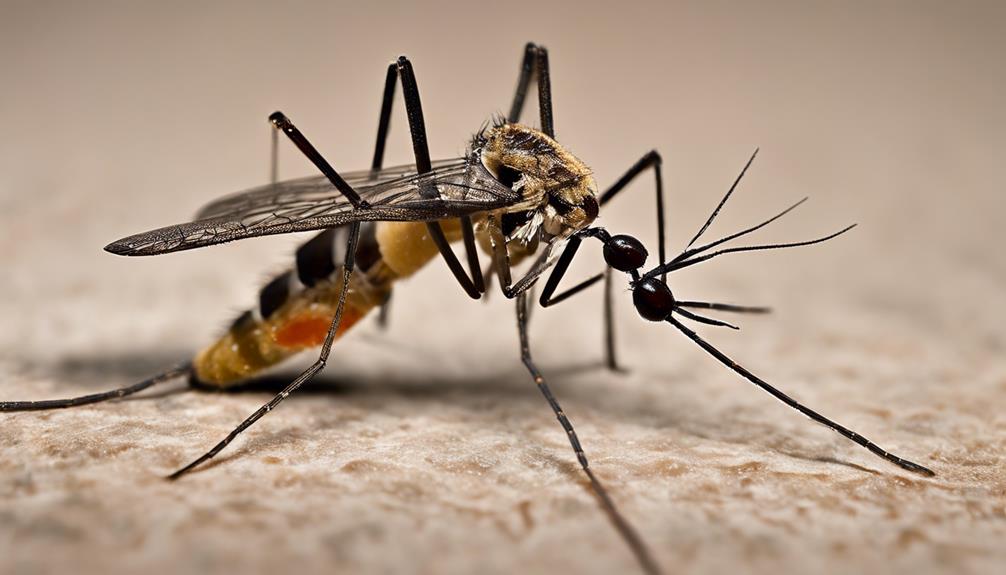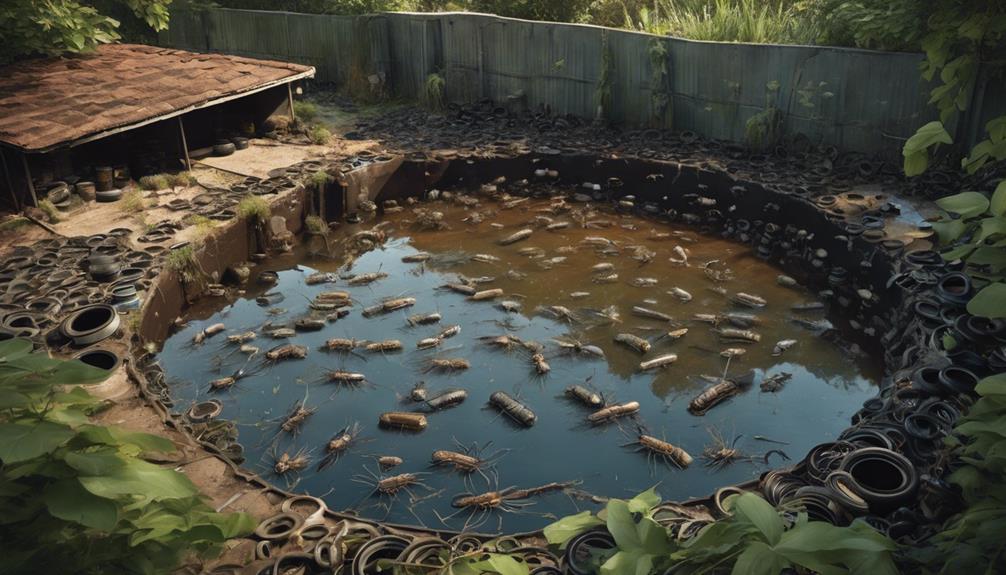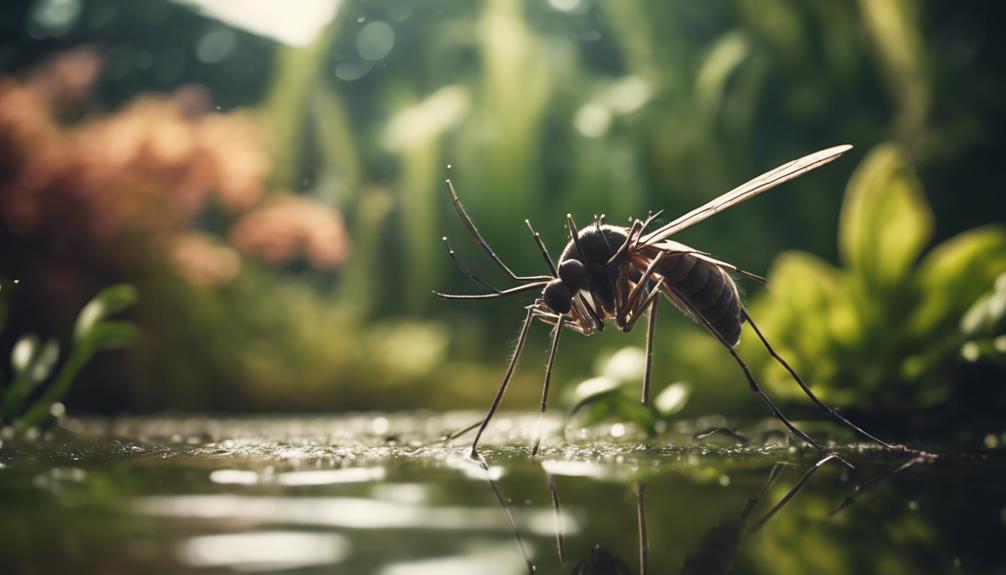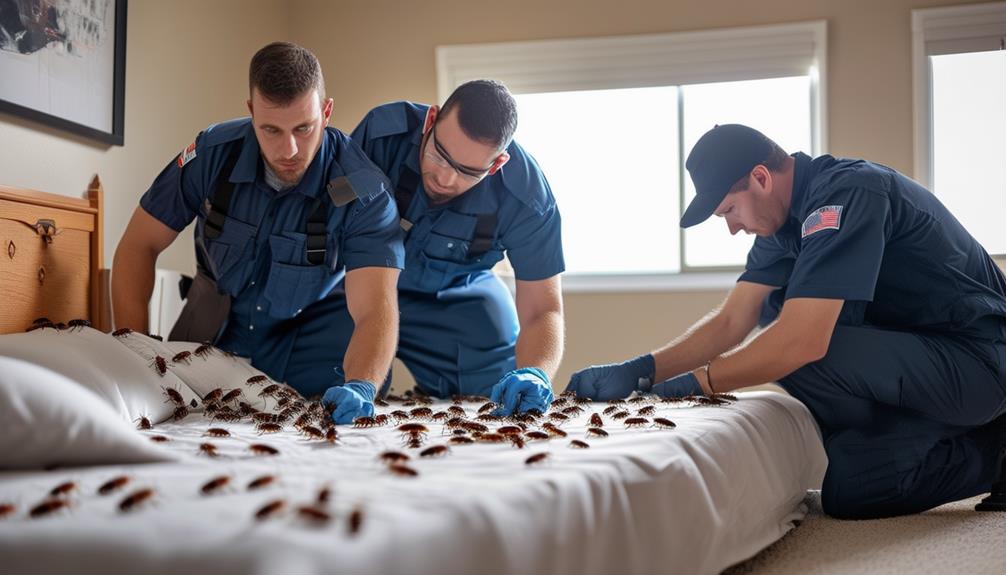Mosquitoes in St. George are essential as they spread diseases like dengue and Zika, impacting both humans and the ecosystem. Aedes aegypti, common in St. George, transmits illnesses like chikungunya. Control efforts target breeding areas to reduce disease spread. Strategies include precise pesticide use and eliminating breeding spots. Residents must act to prevent infestations and safeguard against bites. Collaborating with authorities aids in effective control. Sanitation practices and ecosystem management impact breeding sites greatly. Focus on waste management and water cleanliness. Maintaining a balanced ecosystem involves biodiversity and sustainable controls. Understanding these roles is crucial for a harmonious ecosystem.
Key Takeaways
- Aedes aegypti mosquitoes are vectors for diseases like dengue, Zika, and chikungunya in St. George.
- Mosquito surveillance targets breeding sites to minimize disease transmission.
- Mosquito control strategies involve eliminating breeding sites and larval control methods.
- Proper waste management and clean water availability impact mosquito breeding sites.
- Implementing preventive measures, like maintaining drainage systems, is crucial for controlling mosquito populations.
Mosquito Species in St. George

In St. George, a diverse array of mosquito species, such as Aedes aegypti, play pivotal roles in the local ecosystems through their distinct feeding behaviors and habitat preferences. Aedes aegypti, commonly known as the yellow fever mosquito, is a significant species in St. George due to its preference for urban habitats and its aggressive daytime biting behavior. This mosquito species thrives in areas with standing water, making residential areas with containers like flower pots and birdbaths ideal breeding grounds. Aedes aegypti is a known vector for diseases like dengue, Zika, and chikungunya, emphasizing the importance of monitoring and controlling its population.
Understanding the behavior and distribution of Aedes aegypti is vital for implementing effective mosquito control strategies in St. George. Surveillance efforts focus on identifying breeding sites and implementing targeted interventions to reduce the population of this species. By studying the habitat preferences and feeding patterns of Aedes aegypti, authorities can better protect the community from potential disease outbreaks.
Mosquito-Borne Diseases in Utah
The prevalence of mosquito species capable of transmitting pathogens in St. George highlights the significant risk of mosquito-borne diseases in Utah, particularly diseases like West Nile virus. Mosquitoes in Utah act as vectors for various diseases, posing a threat to public health. West Nile virus, a prominent concern, can lead to severe illness and even neurological complications in humans. Additionally, other mosquito-borne diseases such as Zika virus are also of concern in the region.
Efforts to combat mosquito-borne diseases in Utah, including St. George, are important. Mosquito control measures aim to reduce the spread of diseases by targeting mosquito populations and their breeding grounds. These initiatives are essential to safeguarding the community from potential outbreaks. The Utah Department of Health advises residents to take precautions against mosquito bites to minimize the risk of contracting these diseases.
Surveillance programs play a crucial role in monitoring mosquito populations and evaluating the potential for disease transmission. By staying informed and actively participating in mosquito control efforts, residents can contribute to mitigating the risk of mosquito-borne diseases in Utah.
Combatting Aedes Aegypti

To combat Aedes aegypti mosquitoes effectively, you must employ prevention methods and control strategies.
These include removing standing water, trimming foliage, and implementing pesticide applications like fogging.
Prevention Methods
Implement proactive measures to combat Aedes aegypti mosquitoes in St. George by employing targeted pesticide applications and eliminating breeding sites. Pesticide applications like fogging are effective in controlling Aedes aegypti populations.
Residents play an essential role in prevention by removing clutter, trimming foliage, and draining standing water to eliminate potential breeding grounds. Prevention is critical to reduce Aedes aegypti numbers and prevent the spread of diseases they carry.
The Southwest Mosquito Abatement & Control District recommends proactive steps to prevent infestations. Aedes aegypti mosquitoes have a flight range of 100 yards and lay long-lasting eggs, underscoring the need for constant vigilance and control measures.
Control Strategies
Consider employing targeted pesticide applications and eliminating breeding sites as effective strategies to combat Aedes aegypti mosquitoes in the St. George ecosystems. Aedes aegypti mosquitoes, identifiable by their black color and white banding, have a flight range of up to 100 yards and lay eggs that can survive for extended periods. Pest control methods such as fogging and removing backyard breeding sources are vital in reducing their population.
Residents should take proactive measures by decluttering yards, trimming foliage, and draining standing water to prevent mosquito breeding. While Aedes aegypti is a nuisance mosquito capable of carrying diseases, it isn’t a primary vector of endemic diseases in Utah. Following Southwest Mosquito Abatement & Control District’s recommendations can help control Aedes aegypti populations effectively.
Proactive Pest Control Measures
In managing mosquito populations within St. George ecosystems, prioritizing proactive pest control measures is essential for effective ecosystem management. Implementing proactive pest control measures is critical in curbing the proliferation of mosquitoes.
Larval control methods, such as eliminating standing water sources where mosquitoes breed, can greatly reduce mosquito populations. Introducing natural predators like dragonflies can serve as a biological control measure to keep mosquito numbers in check.
Regular surveillance and monitoring of mosquito populations provide valuable data for targeted control efforts. Educating the community on personal protection measures like using insect repellents can help decrease mosquito bites and potential disease transmission.
Collaboration with local authorities and pest control agencies is crucial in establishing integrated pest management strategies tailored for St. George ecosystems. By proactively implementing these pest control measures, the impact of mosquitoes on the ecosystem can be effectively managed, creating a more harmonious environment for all.
Eliminating Breeding Sources

To effectively mitigate mosquito populations in St. St. George ecosystems, the eradication of standing water, a key breeding ground for mosquitoes, is essential. Breeding sources such as stagnant water in flower pots, gutters, and bird baths are common hotspots for mosquito reproduction. These areas provide ideal conditions for mosquito larvae to thrive and develop.
Regularly cleaning and maintaining outdoor containers can greatly reduce the likelihood of mosquitoes breeding in these locations. Mosquito larvae rely on water sources for their growth, making the removal of standing water vital for effective control measures. Implementing proper drainage systems and covering containers can further decrease mosquito breeding opportunities in St. St. George ecosystems.
Sanitation Practices in Ecosystems
Implementing effective sanitation practices in St. St. George ecosystems is vital for controlling mosquito populations. Ensuring proper waste management and maintaining clean water sources are essential strategies for reducing mosquito breeding sites.
Waste Management Impact
Proper waste management practices play an essential role in reducing mosquito breeding sites within St. George ecosystems. By implementing sanitation measures such as covering trash bins and ensuring proper waste disposal, you can limit mosquito populations.
Effective waste management is vital in minimizing standing water, which serves as a breeding ground for mosquitoes. Keeping outdoor spaces clean and managing organic waste can prevent the proliferation of these disease-carrying insects.
Additionally, adopting waste reduction strategies can have a substantial impact on mosquito control efforts in St. George ecosystems. By actively participating in waste management practices, you contribute to creating a healthier environment that’s less conducive to mosquito breeding, ultimately benefiting the entire ecosystem.
Clean Water Availability
Clean water availability plays a vital role in reducing mosquito breeding sites within St. George ecosystems. To effectively manage mosquito populations and minimize risks associated with female mosquitoes, consider the following:
- Eliminate Standing Water: Remove any sources of stagnant water, such as clogged gutters or containers, that serve as breeding grounds for female mosquitoes.
- Maintain Water Features: Regularly inspect and upkeep water features to prevent water stagnation and control mosquito breeding sites.
- Proper Drainage Systems: Guarantee proper functioning of drainage systems to prevent water accumulation, reducing the habitat for female mosquitoes.
- Implement Monitoring Practices: Monitor water sources regularly to identify and address any potential breeding sites promptly.
Disease Prevention Strategies
Regular removal of standing water sources is essential for preventing mosquito larvae development and enhancing disease prevention strategies in St. George ecosystems. Implementing proper sanitation practices, such as maintaining clean and dry environments and managing waste effectively, can greatly reduce mosquito breeding grounds. By ensuring proper drainage systems and eliminating stagnant water, you can help control mosquito populations and minimize the risk of mosquito-borne diseases. Sanitation efforts play an important role in creating inhospitable conditions for mosquitoes to thrive in. Stay proactive in your sanitation practices to contribute to a healthier ecosystem and community.
| Sanitation Practices | Benefits | Implementation |
|---|---|---|
| Remove standing water | Prevents mosquito breeding | Regular checks |
| Maintain clean environments | Deters mosquito thriving | Cleaning schedules |
| Proper waste management | Controls mosquito populations | Recycling programs |
Impact on Resident Health
Mosquitoes in St. George play a significant role in impacting resident health by transmitting diseases such as West Nile virus. This has several implications for the well-being of individuals in the area:
- Increased Disease Risk: The prevalence of mosquitoes capable of transmitting diseases elevates the risk of residents contracting illnesses like West Nile virus, leading to potential health complications.
- Health Concerns: Residents face health concerns due to the potential transmission of diseases by mosquitoes, necessitating preventive measures to safeguard their well-being.
- Importance of Mosquito Control: Given the health risks posed by mosquito-borne diseases, essential mosquito control measures are vital in St. George to mitigate these risks and protect residents.
- Potential Allergic Reactions: Mosquito bites can cause discomfort and allergic reactions in residents, underscoring the need for proactive measures to minimize exposure to these insects.
Understanding the impact of mosquitoes on resident health underscores the significance of implementing strategies to reduce disease transmission and promote a healthier living environment in St. George.
Reducing Mosquito Breeding

To effectively reduce mosquito breeding in St. St. George, proper management of stagnant water sources is essential. Eliminating areas where water accumulates, such as birdbaths and clogged gutters, can greatly decrease mosquito populations. Regular maintenance of containers like flower pots and buckets by emptying and cleaning them disrupts the mosquito breeding cycle by removing potential egg-laying sites. Additionally, the strategic use of larvicides in persistent standing water areas can target mosquito larvae effectively, inhibiting their growth and reducing the number of adult mosquitoes. Installing screens on windows and doors acts as a physical barrier to prevent adult mosquitoes from entering homes and potentially laying eggs indoors. Community involvement through educational campaigns is vital in fostering a sense of responsibility and collective action in mosquito control efforts. By implementing these practices, you can contribute to a healthier ecosystem and reduce the nuisance of mosquitoes in your surroundings.
| Strategies to Reduce Mosquito Breeding | ||
|---|---|---|
| Eliminate stagnant water sources | Regularly empty and clean containers | Use larvicides in standing water areas |
| Install screens on windows and doors | Encourage community participation |
Protecting the Ecosystem
Protecting the intricate balance of ecosystem health in St. George requires a holistic approach that recognizes the interconnectedness of various species and their roles within the environment. To safeguard the ecosystem while considering the importance of generalist pollinators like mosquitoes, you should:
- Promote Biodiversity: By managing mosquito populations effectively, you can guarantee that these generalist pollinators continue to play their role in pollinating various plant species, contributing to the overall biodiversity of the region.
- Implement Sustainable Strategies: Utilize eco-friendly methods to control mosquito populations, such as introducing natural predators or using targeted biological controls. This approach can protect native flora and fauna while maintaining a healthy ecosystem.
- Educate the Community: Raise awareness about the significance of generalist pollinators like mosquitoes in maintaining ecosystem balance. Encouraging community involvement in conservation efforts can lead to more sustainable practices.
- Monitor Ecosystem Health: Regularly assess mosquito populations and their feeding habits to understand their impact on the ecosystem. This knowledge can guide conservation efforts to preserve natural habitats in St. George effectively.
Community Guidelines for Prevention

How can the community effectively collaborate to implement preventive measures against mosquito proliferation in St. George ecosystems?
To combat the spread of mosquitoes, a collective effort is essential. Start by eliminating standing water breeding grounds through proper waste disposal and drainage systems. Educating residents about these practices is vital to reduce mosquito populations substantially.
Additionally, promoting the use of mosquito repellents and protective clothing during peak mosquito activity times can help prevent mosquito bites. Installing screens on windows and doors acts as a physical barrier, preventing mosquitoes from entering homes.
Collaborating with local authorities to implement targeted mosquito control measures, such as larviciding, is a highly effective way to manage mosquito populations in St. George ecosystems. By working together and following these guidelines, the community can create a more resilient environment that’s less hospitable to mosquitoes, ultimately benefiting everyone in St. George.
Frequently Asked Questions
How Are Mosquitoes Important to the Ecosystem?
Mosquitoes are vital to the ecosystem as they serve as food for various predators like fish, frogs, and birds. Understanding their role helps maintain balance in St. George. They’re essential for the survival of many species.
Are There Mosquitoes in St George Utah?
Yes, there are mosquitoes in St. George, Utah. Despite their presence, effective mosquito control measures like eliminating breeding sites, using larvicides, and educating residents help manage their impact on public health.
What Diseases Do Mosquitoes Carry in Utah?
In Utah, mosquitoes can carry diseases like West Nile virus, St. Louis encephalitis virus, and Western equine encephalitis virus. It’s essential to focus on mosquito control to prevent these illnesses and safeguard public health.
What Is the Function of the Mosquito?
In the world of insects, the mosquito reigns as a versatile creature. Mosquito behavior is fascinating, from pollinating plants to serving as a crucial link in the food chain. Understanding their functions illuminates their significance.




